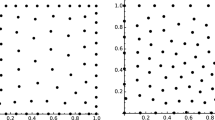Abstract
We study the distances, called spacings, between pairs of neighboring energy levels for the quantum harmonic oscillator. Specifically, we consider all energy levels falling between E and E+1, and study how the spacings between these levels change for various choices of E, particularly when E goes to infinity. Primarily, we study the case in which the spring constant is a badly approximable vector. We first give the proof by Boshernitzan-Dyson that the number of distinct spacings has a uniform bound independent of E. Then, if the spring constant has components forming a basis of an algebraic number field, we show that, when normalized up to a unit, the spacings are from a finite set. Moreover, in the specific case that the field has one fundamental unit, the probability distribution of these spacings behaves quasiperiodically in logE. We conclude by studying the spacings in the case that the spring constant is not badly approximable, providing examples for which the number of distinct spacings is unbounded.
Similar content being viewed by others
References
Bleher, P.M.: The energy level spacing for two harmonic oscillators with golden mean ratio of frequencies. J. Stat. Phys. 61(3–4), 869–876 (November 1990)
Bleher, P.M.: The energy level spacing for two harmonic oscillators with generic ratio of frequencies. J. Stat. Phys. 63(1–2), 261–283 (April 1991)
Boshernitzan, M.D.: Letter to F.J. Dyson. December 9 (1991)
Boshernitzan, M.D.: Letter to F.J. Dyson. May 20 (1992)
Cassels, J.W.S.: An Introduction to Diophantine Approximation. Cambridge University Press, Cambridge (1965)
Chevallier, N.: Three distance theorem and grid graph. Discrete Math. 223, 355–362 (January 2000)
Dani, S.G.: Divergent trajectories of flows on homogeneous spaces and Diophantine approximation. J. Reine Angew. Math. 359, 55–89 (1985)
Dyson, F.J.: Nearest neighbor distances on a circle. Preprint
Geelen, J.F., Simpson, R.J.: A two dimensional Steinhaus theorem. Australas. J. Combin. 8, 169–197 (1993)
Greenman, C.D.: The generic spacing distribution of the two-dimensional harmonic oscillator. J. Phys. A, Math. Gen. 29, 4065–4081 (1996)
Marklof, J.: The n-point correlations between values of a linear form. Ergod. Theory Dyn. Syst. 20, 1127–1172 (2000)
Marcus, D.A.: Number Fields. Springer, New York (1977)
Moore, C.C.: Ergodicity of flows on homogeneous spaces. Am. J. Math. 88, 154–178 (1966)
Perron, O.: Über diophantische Approximationen. Math. Ann. 83(1–2), 77–84 (1921)
Schmidt, W.M.: Diophantine Approximations and Diophantine Equations. Lecture Notes in Mathematics, vol. 1467. Springer, Berlin (1991)
Sós, V.T.: On the distribution mod 1 of the sequence nα. Ann. Univ. Sci. Budapest. Eotvos Sect. Math. 1 127–134 (1958)
Author information
Authors and Affiliations
Corresponding author
Rights and permissions
About this article
Cite this article
Bleher, P.M., Homma, Y., Ji, L.L. et al. Nearest Neighbor Distances on a Circle: Multidimensional Case. J Stat Phys 146, 446–465 (2012). https://doi.org/10.1007/s10955-011-0367-8
Received:
Accepted:
Published:
Issue Date:
DOI: https://doi.org/10.1007/s10955-011-0367-8




